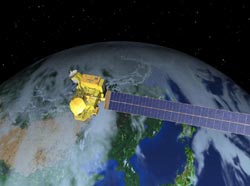|
|
Sci-Tech
Japan-United States GPS Cooperation Enhanced ``for Peaceful Purposes``
Saturday, January 15, 2011

Tokyo - (PanOrient News) The Governments of the United States of America and Japan convened a plenary meeting in Tokyo, Japan on January 13, to review and discuss cooperation in the civil use of the Global Positioning System (GPS) and GPS augmentations, including Japan's Multi-functional Transport Satellite (MTSAT) Satellite-based Augmentation System (MSAS) and Quasi-Zenith Satellite Systems (QZSS).
According to a statement issued by the Japanese Foreign Ministry, the GPS consultations are held regularly pursuant to the "Joint Statement on Cooperation in the Use of the Global Positioning System" signed by the heads of the two Governments on September 22, 1998.
During the meeting, the United States (U.S.) representatives described the status of Wide Area Augmentation System (WAAS) and GPS modernization and the United States' international GPS cooperation with third parties, the statement said.
Representatives of the Government of Japan reported on the status of the MSAS and QZSS programs and on Japan's international Global Navigation Satellite System (GNSS) - related cooperation activities. Both Governments reaffirmed the importance of providing open access to basic space-based positioning, navigation and timing (PNT) services for peaceful purposes, free of direct user fees, the ministry said.
In the meeting, "both Governments reiterated that GPS and its augmentations have become indispensable for modern life in the U.S., Japan and the world, providing essential services and increased efficiencies in a broad range of applications, such as aviation and maritime safety-of-life, geodetic surveying, car and personal navigation, mobile telephone timing, international financial transactions and electric power transmission."
Additionally, representatives of both Governments reviewed the ongoing work of the GPS/QZSS Technical Working Group (TWG), which was established to foster close cooperation during the development of QZSS. The TWG reaffirmed that GPS and QZSS are designed to be compatible and highly interoperable.
Both Governments noted with satisfaction that the Japan Aerospace Exploration Agency (JAXA) and the U.S. National Oceanic and Atmospheric Administration (NOAA) have commenced operations of a QZSS Monitoring Station (MS) on NOAA property in Guam, the statement said.
"A similar effort between JAXA and the U.S. National Aeronautics and Space Administration (NASA) to establish both a QZSS MS and a Two-Way Satellite Time and Frequency Transfer station at a NASA facility in Hawaii, in support of Japan's National Institute of Information and Communications Technology (NICT) and the U.S. Naval Observatory (USNO), is expected to be completed shortly. Both Governments intend to continue cooperation in protecting spectrum used for GNSS and also reaffirmed the importance of pursuing the interoperability and compatibility of all current and planned GNSS with GPS and QZSS."
This 8th Plenary meeting strengthened cooperative relations between the United States and Japan and both Governments acknowledged the important future contribution of QZSS to the space-based PNT services of Japan. They affirmed that continued close cooperation in the area of navigation satellite system will contribute to the peaceful development of the Asia-Pacific region and promote global economic growth.
In that regard, both Governments welcomed the 6th meeting of the International Committee on Global Navigation Satellite Systems (ICG-6) to be held in Tokyo, September 5-9, 2011 and the 3rd Asia Oceania Regional Workshop on GNSS to be held in Japan's fiscal year 2011, the statement concluded.
Photo: Courtesy of Japan Aerospace Exploration Agency (JAXA)
PanOrient News
© PanOrient News All Rights Reserved.
|
|

